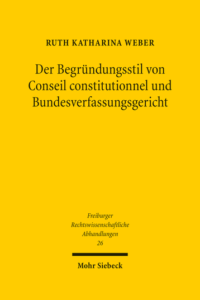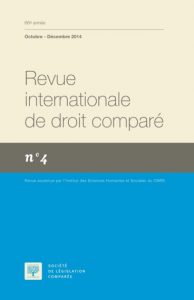Fév 12, 2020
Données bibliographiques / Bibliografische Daten |
|---|
| Auteurs / Autoren: | WEBER RUTH KATARINA |
|---|
| Source / Fundstelle: | Der Begründungsstil von Conseil constitutionnel und Bundesverfassungsgericht: Eine vergleichende Analyse der Spruchpraxis |
|---|
| Année / Jahr: | 2019 |
|---|
| Localisation / Standort: | Mohr Siebeck, coll. Freiburger Rechtswissenschaftliche Abhandlungen |
|---|
| Catégorie / Kategorie: | Rechtspraxis, Rechtsvergleichung, Verfassungsprozeßrecht, Verfassungsrecht |
|---|

Résumé: Le style, c'est la Cour! - Im Mittelpunkt dieser Arbeit stand die Frage nach dem Begründungsstil von Conseil constitutionnel und Bundesverfassungsgericht und dem darin transportierten Selbstverständnis. Dieses wurde im Ausgangspunkt für den Conseil constitutionnel als das einer autoritären "bouche de la Constitution" und für das Bundesverfassungsgericht als das einer differenzierten Verkörperung des Verfassungsrechtsstaats - die empirische Auswertung, die justizkulturelle Verankerung und die institutionellen Voraussetzungen. Der erste Teil nähert sich der dichotomen Gegenüberstellung der Begründungsstile des französischen und deutschen Verfassungsgerichts an. Mit Hilfe des Parameters der Entscheidungslänge zeigen sich wesentliche Charakteristika des Begründungsstils der beiden Gerichte. Die anfänglich sehr knappen Entscheidungen des Conseil constitutionnel in Normenkontrollverfahren werden über die Jahre immer länger. Der Anstieg der Seitenanzahl geht zum einen mit Veränderungen im Verfassungsprozessrecht einher. So stiegen mit der Verfassungsreform von 1974, nach der auch eine parlamentarische Minderheit ein Gesetz durch den Conseil constitutionnel überprüfen lassen kann, nicht nur die Verfahrenszahlen insgesamt an, sondern mit etwas Verzögerung auch die Länge der Entscheidungen. Die Entscheidungsbegründung intensivierte sich wegen ausführlich argumentierter Normenkontrollanträge und eines größeren Rechtfertigungsdrucks des fortan stärker in den politischen Prozess eingefügten Conseil constitutionnel zumindest graduell. Auch die Senatsentscheidungen des Bundesverfassungsgerichts werden immer länger. Diese langen Entscheidungen muten wie Monographien an und behandeln die aufgeworfene Rechtsfrage über das entscheidungserhebliche Problem hinaus. Selbst aus der Perspektive der Bundesverfassungsrichter ist der Umfang der Entscheidungen zu einer "parakonstitutionellen Rechtsmasse" angewachsen. Im Vergleich zum Conseil constitutionnel werden die Entscheidungen zwar auch länger, sind aber bereits von Anfang an sehr umfangreich. Deshalb liefert die Gegenüberstellung auch die Erkenntnis, dass der Conseil constitutionnel in seiner institutionellen Position noch unsicherer ist. Während das Bundesverfassungsgericht wichtige Entscheidungen besonders ausführlich begründet, fällt die Entscheidungsbegründung des Conseil constitutionnel bei komplizierten Rechtsfragen eher knapp aus. Der zweite Teil der Arbeit behandelte die Frage nach der Verankerung des Begründungsstils auf einem abstrakten, formelhaften Niveau. In Frankreich spielt die Tradition eine ausschlaggebende Rolle. Unter Berufung auf die Französische Revolution wird der Begründungsstil der französischen Höchstgerichtsbarkeit als Ausdruck der dienenden Rolle im System der Gewaltenteilung verstanden. Die Gerichtsbarkeit legte im Laufe des 19. Jahrhunderts zudem etwa durch die Abschaffung des sich als impraktikabel herausstellenden "référé législatif" ihre untergeordnete Rolle ab. Das Bundesverfassungsgericht bedient sich vielfältiger einleitender und abschließender Bausteine. Das durch das Aufklärungsdenken geprägte Richterbild eines mechanischen Automaten steht in Wechselwirkung mit dem Begründungsstil französischer Höchstgerichte. Die Kritik an diesem Begründungsstil setzte rasch ein und erfuhr immer wieder Höhepunkte, wie etwa Anfang der 1970er Jahre, als André Tunc und Adolphe Touffait in einer Kampfschrift dem Begründungsstil der Cour de cassation Unzeitgemäßheit und Inhaltsleere vorwarfen. Trotz der Reformbestrebungen bleibt die Aufspaltung des jurisdiktionellen Diskurses in die Entscheidung selbst und daneben existierende, häufig der Entscheidungserläuterung dienende Begleitdokumente, wie die Rapports und Notes, weiter bestehen. Sowohl in Frankreich als auch in Deutschland entspringt der Begründungsstil vor allen Dingen einer über Jahrhunderte tradierten Art der Entscheidungsredaktion, die sich aus einem ganzen Bündel von Faktoren zusammensetzt. Eine Untersuchung der institutionellen Prämissen der Verfassungsgerichtsbarkeit in Frankreich und Deutschland erfolgt im dritten Teil der Arbeit. Die ermittelten historisch gewachsenen justizkulturellen und institutionellen Prämissen bedingen das Selbstverständnis des nationalen Richters und damit dessen Begründungsstil. Die Unterschiede der Begründungsstile der Spruchpraxen von Conseil constitutionnel und Bundesverfassungsgericht lassen sich daher abgesehen von den justizkulturell verschiedenartig gewachsenen Gewohnheiten vor allem mit den institutionellen Grundvoraussetzungen erklären. Sie beziehen sich neben den Richtern auf das sonstige Gerichtspersonal und auf die systematische Stellung der Rechtswissenschaft.
Nov 15, 2019
 Zugang zu nationalen und internationalen Gerichten gegen das Handeln der Exekutive - aktuelle Praxis im Dialog zwischen Wissenschaft und Praxis.
Zugang zu nationalen und internationalen Gerichten gegen das Handeln der Exekutive - aktuelle Praxis im Dialog zwischen Wissenschaft und Praxis.
Résumé: Cette contribution donne un rapport du colloque franco-allemand qui a eu lieu les 7 et 8 septembre 2018 au Centre Panthéon à Paris. Au coeur du colloque organisé par les Universités Paris 1 Panthéon-Sorbonne, Paris 2 Panthéon-Assas et l'Université des sciences administratives de Spire était la question de l'accès au juge qu'il soit national ou international contre les actes du pouvoir exécutif. Après un début sur l'art. 6 CEDH, les participants ont bénéficié d'une explication de la situation en Allemagne puis de celle en France. La question de la demande d'asile et notamment de l'accès au juge dans ce cas de figure a été examiné dans le cadre juridique de l'un et de l'autre pays, tout comme le droit de la commande publique et les influences qu'a eu le droit de l'Union européenne sur la réglementation de part et d'autres de la frontière.
Note: Les actes du colloque, avec des contributions en français et en allemand, sont en cours de publication aux éditions Springer (collection "Beiträge zum ausländischen öffentlichen Recht und Völkerrecht").
Oct 30, 2019
Données bibliographiques / Bibliografische Daten |
|---|
| Auteurs / Autoren: | WALDHOFF, CHRISTIAN; WITTMER, FABIUS |
|---|
| Source / Fundstelle: | https://www.cambridge.org/core/journals/german-law-journal/article/religious-education-in-germany-in-light-of-religious-diversity-constitutional-requirements-for-religious-education/DA53CF0E68B465C7FD4E027BAD3887AF# |
|---|
| Revue / Zeitschrift: | German Law Journal |
|---|
| Année / Jahr: | 2019 |
|---|
| Localisation / Standort: | German Law Journal, Volume 20, Issue 7, pp. 1047-1065 |
|---|
| Catégorie / Kategorie: | Droit de la religion, Religionsrecht |
|---|
| Mots clef / Schlagworte: | Religionsrecht, Religionsverfassungsrecht, Éducation religieuse, Enseignement de la religion |
|---|
 Abstract:
Abstract:
In Article 7, paragraph 3, the German Constitution provides that religious education shall be a part of the curriculum of public school. This is one of the three approaches of dealing with religious education existing today. Originally, religious education as a regular subject at public schools in Germany was only offered by the two Christian Churches—Catholic and Protestant. As the number of Christians decreased and the number of Muslims increased, the demand for Islamic religious education at public schools grew. Therefore, the question arose whether the constitutional law concerning religion is capable of facing the new challenges of religious diversity. This article tries to answer this question with regard to the introduction of Islamic religious education as a measure of adaptiveness. In the first step, the requirements of Article 7, paragraph 3 of the Constitution posed to religious education will be outlined in order to be able to examine in the second step whether Islamic religious education may be introduced at public schools as a regular subject. In this regard, the issue of the qualification of an umbrella association as a religious society and the constitutionality of the advisory board model will be discussed.
Oct 30, 2019
 Abstract by German Law Journal
Abstract by German Law Journal :
The law on state-church relations is no longer exclusively a national concern of the EU Member States. Despite supposedly strict neutrality clauses in the primary law of the EU and rigid statements—
inter alia—by the German Federal Constitutional Court, it is safe to assume the formation of a supranational EU law on religion, which also touches upon the status of the churches and religious associations. This becomes obvious when state-church relations in Europe are reconstructed as a double conflict of laws that comprises interlocked conflicts between ecclesiastical law and worldly law, as well as between EU law and national law. Within the triangular relationship of these different legal spheres, EU law steers state-church relations towards the non-discrimination principle. The controversy in German law on religion between the proponents of a collective, institutionalist understanding (classic “Staatskirchenrecht”) and advocates of a rather fundamental rights-centered, individualist reading of the Constitution (“Religionsverfassungsrecht”) hence needs to be reconsidered. EU law calls for including yet a third paradigm into the debate: Equality.
Juin 24, 2019
Données bibliographiques / Bibliografische Daten |
|---|
| Auteurs / Autoren: | HUBERT, JULIANE; GÖRLITZ, FRANZISKA; KUCHER, JASMIN; SCHEFFER, MORITZ; WIESER, PATRICK |
|---|
| Source / Fundstelle: | https://www.cambridge.org/core/journals/german-law-journal/article/tatprovokation-the-legal-issue-of-entrapment-in-germany-and-possible-solutions/964310727F53984D02FB1BB6031289E3 |
|---|
| Revue / Zeitschrift: | German Law Journal |
|---|
| Année / Jahr: | 2019 |
|---|
| Localisation / Standort: | German Law Journal, Volume 20, Issue 4, pp. 496-509 |
|---|
| Catégorie / Kategorie: | Droit pénal, Strafrecht |
|---|
| Mots clef / Schlagworte: | Tatprovokation, Provocation à l'infraction, Provocation à la preuve |
|---|
 Abstract:
Abstract:
Incitement by police officers is a well-known and often utilized police measure in the German investigation process. Yet, when it comes to prosecuting the perpetrators, a moral conflict arises. Should a State, bound by its own constitution and committed to protect its citizens, be allowed to incite or support a possible offender and afterwards judge on his or her wrongful actions? After Germany’s higher courts had to deal with multiple cases of entrapped perpetrators, there has been a strong debate about the admissibility, requirements, and consequences of entrapment within the German legal system. International and national courts as well as scholars represent different legal standpoints in this regard. In particular, the approaches of the European Court of Human Rights and the German Federal Court of Justice differ significantly in their results. As Germany ratified the European Convention on Human Rights and therefore has to adhere to the European Court of Human Rights’ ruling, an additional legal conflict arises. This article depicts and discusses the most relevant approaches to resolve this moral and legal conflict and satisfy both the need for effective prosecution and the procedural rights of the individual person subject to the act of entrapment. Additionally, recent legislative ambitions are presented.

 Résumé: Le style, c'est la Cour! - Im Mittelpunkt dieser Arbeit stand die Frage nach dem Begründungsstil von Conseil constitutionnel und Bundesverfassungsgericht und dem darin transportierten Selbstverständnis. Dieses wurde im Ausgangspunkt für den Conseil constitutionnel als das einer autoritären "bouche de la Constitution" und für das Bundesverfassungsgericht als das einer differenzierten Verkörperung des Verfassungsrechtsstaats - die empirische Auswertung, die justizkulturelle Verankerung und die institutionellen Voraussetzungen. Der erste Teil nähert sich der dichotomen Gegenüberstellung der Begründungsstile des französischen und deutschen Verfassungsgerichts an. Mit Hilfe des Parameters der Entscheidungslänge zeigen sich wesentliche Charakteristika des Begründungsstils der beiden Gerichte. Die anfänglich sehr knappen Entscheidungen des Conseil constitutionnel in Normenkontrollverfahren werden über die Jahre immer länger. Der Anstieg der Seitenanzahl geht zum einen mit Veränderungen im Verfassungsprozessrecht einher. So stiegen mit der Verfassungsreform von 1974, nach der auch eine parlamentarische Minderheit ein Gesetz durch den Conseil constitutionnel überprüfen lassen kann, nicht nur die Verfahrenszahlen insgesamt an, sondern mit etwas Verzögerung auch die Länge der Entscheidungen. Die Entscheidungsbegründung intensivierte sich wegen ausführlich argumentierter Normenkontrollanträge und eines größeren Rechtfertigungsdrucks des fortan stärker in den politischen Prozess eingefügten Conseil constitutionnel zumindest graduell. Auch die Senatsentscheidungen des Bundesverfassungsgerichts werden immer länger. Diese langen Entscheidungen muten wie Monographien an und behandeln die aufgeworfene Rechtsfrage über das entscheidungserhebliche Problem hinaus. Selbst aus der Perspektive der Bundesverfassungsrichter ist der Umfang der Entscheidungen zu einer "parakonstitutionellen Rechtsmasse" angewachsen. Im Vergleich zum Conseil constitutionnel werden die Entscheidungen zwar auch länger, sind aber bereits von Anfang an sehr umfangreich. Deshalb liefert die Gegenüberstellung auch die Erkenntnis, dass der Conseil constitutionnel in seiner institutionellen Position noch unsicherer ist. Während das Bundesverfassungsgericht wichtige Entscheidungen besonders ausführlich begründet, fällt die Entscheidungsbegründung des Conseil constitutionnel bei komplizierten Rechtsfragen eher knapp aus. Der zweite Teil der Arbeit behandelte die Frage nach der Verankerung des Begründungsstils auf einem abstrakten, formelhaften Niveau. In Frankreich spielt die Tradition eine ausschlaggebende Rolle. Unter Berufung auf die Französische Revolution wird der Begründungsstil der französischen Höchstgerichtsbarkeit als Ausdruck der dienenden Rolle im System der Gewaltenteilung verstanden. Die Gerichtsbarkeit legte im Laufe des 19. Jahrhunderts zudem etwa durch die Abschaffung des sich als impraktikabel herausstellenden "référé législatif" ihre untergeordnete Rolle ab. Das Bundesverfassungsgericht bedient sich vielfältiger einleitender und abschließender Bausteine. Das durch das Aufklärungsdenken geprägte Richterbild eines mechanischen Automaten steht in Wechselwirkung mit dem Begründungsstil französischer Höchstgerichte. Die Kritik an diesem Begründungsstil setzte rasch ein und erfuhr immer wieder Höhepunkte, wie etwa Anfang der 1970er Jahre, als André Tunc und Adolphe Touffait in einer Kampfschrift dem Begründungsstil der Cour de cassation Unzeitgemäßheit und Inhaltsleere vorwarfen. Trotz der Reformbestrebungen bleibt die Aufspaltung des jurisdiktionellen Diskurses in die Entscheidung selbst und daneben existierende, häufig der Entscheidungserläuterung dienende Begleitdokumente, wie die Rapports und Notes, weiter bestehen. Sowohl in Frankreich als auch in Deutschland entspringt der Begründungsstil vor allen Dingen einer über Jahrhunderte tradierten Art der Entscheidungsredaktion, die sich aus einem ganzen Bündel von Faktoren zusammensetzt. Eine Untersuchung der institutionellen Prämissen der Verfassungsgerichtsbarkeit in Frankreich und Deutschland erfolgt im dritten Teil der Arbeit. Die ermittelten historisch gewachsenen justizkulturellen und institutionellen Prämissen bedingen das Selbstverständnis des nationalen Richters und damit dessen Begründungsstil. Die Unterschiede der Begründungsstile der Spruchpraxen von Conseil constitutionnel und Bundesverfassungsgericht lassen sich daher abgesehen von den justizkulturell verschiedenartig gewachsenen Gewohnheiten vor allem mit den institutionellen Grundvoraussetzungen erklären. Sie beziehen sich neben den Richtern auf das sonstige Gerichtspersonal und auf die systematische Stellung der Rechtswissenschaft.
Résumé: Le style, c'est la Cour! - Im Mittelpunkt dieser Arbeit stand die Frage nach dem Begründungsstil von Conseil constitutionnel und Bundesverfassungsgericht und dem darin transportierten Selbstverständnis. Dieses wurde im Ausgangspunkt für den Conseil constitutionnel als das einer autoritären "bouche de la Constitution" und für das Bundesverfassungsgericht als das einer differenzierten Verkörperung des Verfassungsrechtsstaats - die empirische Auswertung, die justizkulturelle Verankerung und die institutionellen Voraussetzungen. Der erste Teil nähert sich der dichotomen Gegenüberstellung der Begründungsstile des französischen und deutschen Verfassungsgerichts an. Mit Hilfe des Parameters der Entscheidungslänge zeigen sich wesentliche Charakteristika des Begründungsstils der beiden Gerichte. Die anfänglich sehr knappen Entscheidungen des Conseil constitutionnel in Normenkontrollverfahren werden über die Jahre immer länger. Der Anstieg der Seitenanzahl geht zum einen mit Veränderungen im Verfassungsprozessrecht einher. So stiegen mit der Verfassungsreform von 1974, nach der auch eine parlamentarische Minderheit ein Gesetz durch den Conseil constitutionnel überprüfen lassen kann, nicht nur die Verfahrenszahlen insgesamt an, sondern mit etwas Verzögerung auch die Länge der Entscheidungen. Die Entscheidungsbegründung intensivierte sich wegen ausführlich argumentierter Normenkontrollanträge und eines größeren Rechtfertigungsdrucks des fortan stärker in den politischen Prozess eingefügten Conseil constitutionnel zumindest graduell. Auch die Senatsentscheidungen des Bundesverfassungsgerichts werden immer länger. Diese langen Entscheidungen muten wie Monographien an und behandeln die aufgeworfene Rechtsfrage über das entscheidungserhebliche Problem hinaus. Selbst aus der Perspektive der Bundesverfassungsrichter ist der Umfang der Entscheidungen zu einer "parakonstitutionellen Rechtsmasse" angewachsen. Im Vergleich zum Conseil constitutionnel werden die Entscheidungen zwar auch länger, sind aber bereits von Anfang an sehr umfangreich. Deshalb liefert die Gegenüberstellung auch die Erkenntnis, dass der Conseil constitutionnel in seiner institutionellen Position noch unsicherer ist. Während das Bundesverfassungsgericht wichtige Entscheidungen besonders ausführlich begründet, fällt die Entscheidungsbegründung des Conseil constitutionnel bei komplizierten Rechtsfragen eher knapp aus. Der zweite Teil der Arbeit behandelte die Frage nach der Verankerung des Begründungsstils auf einem abstrakten, formelhaften Niveau. In Frankreich spielt die Tradition eine ausschlaggebende Rolle. Unter Berufung auf die Französische Revolution wird der Begründungsstil der französischen Höchstgerichtsbarkeit als Ausdruck der dienenden Rolle im System der Gewaltenteilung verstanden. Die Gerichtsbarkeit legte im Laufe des 19. Jahrhunderts zudem etwa durch die Abschaffung des sich als impraktikabel herausstellenden "référé législatif" ihre untergeordnete Rolle ab. Das Bundesverfassungsgericht bedient sich vielfältiger einleitender und abschließender Bausteine. Das durch das Aufklärungsdenken geprägte Richterbild eines mechanischen Automaten steht in Wechselwirkung mit dem Begründungsstil französischer Höchstgerichte. Die Kritik an diesem Begründungsstil setzte rasch ein und erfuhr immer wieder Höhepunkte, wie etwa Anfang der 1970er Jahre, als André Tunc und Adolphe Touffait in einer Kampfschrift dem Begründungsstil der Cour de cassation Unzeitgemäßheit und Inhaltsleere vorwarfen. Trotz der Reformbestrebungen bleibt die Aufspaltung des jurisdiktionellen Diskurses in die Entscheidung selbst und daneben existierende, häufig der Entscheidungserläuterung dienende Begleitdokumente, wie die Rapports und Notes, weiter bestehen. Sowohl in Frankreich als auch in Deutschland entspringt der Begründungsstil vor allen Dingen einer über Jahrhunderte tradierten Art der Entscheidungsredaktion, die sich aus einem ganzen Bündel von Faktoren zusammensetzt. Eine Untersuchung der institutionellen Prämissen der Verfassungsgerichtsbarkeit in Frankreich und Deutschland erfolgt im dritten Teil der Arbeit. Die ermittelten historisch gewachsenen justizkulturellen und institutionellen Prämissen bedingen das Selbstverständnis des nationalen Richters und damit dessen Begründungsstil. Die Unterschiede der Begründungsstile der Spruchpraxen von Conseil constitutionnel und Bundesverfassungsgericht lassen sich daher abgesehen von den justizkulturell verschiedenartig gewachsenen Gewohnheiten vor allem mit den institutionellen Grundvoraussetzungen erklären. Sie beziehen sich neben den Richtern auf das sonstige Gerichtspersonal und auf die systematische Stellung der Rechtswissenschaft.


